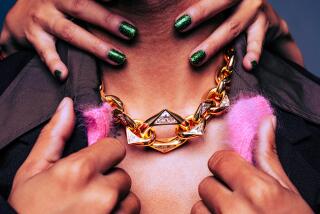Platinum Jewelry Is Making a Fierce Comeback : Marketing: A Newport Beach trade group has been instrumental in the revival of the heavy, pure precious metal. World War II halted its use.
- Share via
NEW YORK — When Geri Bondanza first started selling platinum jewelry 18 years ago, there were few takers for the once-popular precious metal.
“No one was looking for platinum anything--there was zero market for it,” said Bondanza, vice president of Michael Bondanza Inc. in New York. “People thought we were crazy to go near the stuff.”
Today, Bondanza laughs about those days, especially as platinum makes a fierce comeback after a 50-year absence. Sales have jumped over 30% in the last three years.
Prior to World War II, platinum was considered the premier metal for jewelry-making. The finest jewelry and most bridal pieces--engagement rings and wedding bands--were exclusively platinum.
Consumers flocked to platinum for its look and feel. Its rich, silvery tone was styled in either a matte or polished fashion. It was also considered the heaviest and purest precious metal, enabling more detailed jewelry designs.
But platinum’s reign came to an abrupt halt during WWII when the U.S. government temporarily restricted its use to military purposes.
“Platinum went from being the ultimate to being virtually unknown in a blink of the eye,” said Laurie Hudson, president of the U.S. office of the Platinum Guild International, a trade group based in Newport Beach, Calif.
When the ban was lifted after the war, platinum was unable to regain its place. Consumers, instead, turned to white gold, which mimicked platinum’s silvery luster but cost less.
It wasn’t until the early 1990s that platinum again found its niche, mostly due to an intensive 10-year drive by the Platinum Guild to educate the public, jewelry designers and retailers about the metal.
“We put ads in magazines, held sales training seminars and we really pushed platinum at every trade show we could,” said Hudson, who opened the U.S. office of the guild in 1992. “There was a whole generation out there that had never even seen platinum.”
During the same period of time, the availability of platinum increased as more mines opened and more sophisticated mining processes were developed.
“It’s still rare, but it wasn’t as hard to get anymore,” said Carl Denney, a spokesman for Johnson Matthey, one of the world’s largest platinum suppliers. “That helped expand the market.”
There are only 133 tons of platinum produced annually, compared to 1,782 tons of gold, the guild said.
Interest eventually caught on, and a generation of consumers--namely young working women between the ages of 18 and 35--started purchasing platinum.
“Platinum is for the ‘90s woman who wants to something that is elegant but understated,” said Rudolf Erdel of OE Design, a New York jewelry maker that specializes in platinum.
Such was true for Andrea Wiesel, a 26-year-old financial analyst, who fell in love with platinum after she got an engagement ring in the metal last year, and has since bought two pins.
“My grandma always said platinum was the best,” she said. “Once I started wearing it, I felt the difference.”
Retailers from major department stores to small jewelers are expanding their platinum collections to reflect the growing demand.
In the last year, Tiffany & Co. introduced two new lines of platinum jewelry, while continuing its tradition of setting all its diamonds in the metal.
“There is a coolness of platinum that you can’t find in other precious metals,” said Jeanne Daniel, vice president of merchandising at Tiffany. “Many people want it because its quality without the flash.”
And there has been a boom of U.S. designers and manufacturers working in platinum. There are more than 250 companies working with the metal today, up from 50 in 1980, the guild said.
Fashion designer Isaac Mizrahi promoted his new platinum and diamond necklace--called “Angel Rings”--during this spring’s New York fashion shows. And jewelry designer Paloma Picasso mixes platinum and gold in her “Little Secrets” collection.
As the number of manufacturers using the metal has grown, so has the consumption level. More than 60,000 ounces of platinum was used in the United States last year for jewelry making, up from 20,000 ounces in 1991, according to Johnson Matthey.
That amount is expected to rise in the coming years, with estimates reaching as high as 190,000 ounces by 1999. That would nearly double what consumption was in the 1920s, the height of the platinum era.
Still, the cost of platinum exceeds all other precious metals, making it pricey for some. On the current commodity markets, platinum is about $430 an ounce, compared to $385 for gold. And many designers are just starting to make smaller, affordable pieces for the general market, said Erdel of OE Design.
“It is expensive,” he said. “We’ve gotten people to notice platinum again, so I guess as the demand goes up [and more platinum is on the market], the price will start to fall.”


